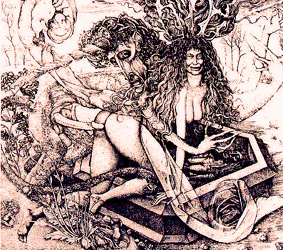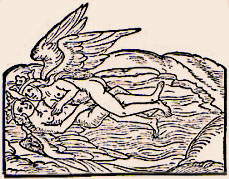|
|

ERNST FUCHS: TEMPTATION OF THE UNICORN
|

ROSARIUM PHILOSOPHORUM
|
|
|
|
|
|
ART OF THE VISIONARY
AND THE PORNOGRAPHIC
L. CARUANA
|
Traditionally, Visionary art tends towards the beautiful, spiritual and sublime in its subject matter. Perhaps because the artists themselves have practised meditation, pursued their visions, and created art with the aim in mind of higher spiritual attainment.
Nevertheless, if Visionary art is concerned with visions that spontaneously arise in an altered state of consciousness, then erotic and even pornographic visions must be included in the genre. Indeed, many artists who have used sacred symbols in their works have also, at times, found themselves on a track leading to images of the sexual.
An example of this is Ernst Fuchs' Temptation of the Unicorn. Many works from his early period (the 1950's) depict Christian symbols in combination with images of sex, death, and the corruption of the flesh. This naturally led to his series of Unicorn engravings, with their rich alchemical symbolism, similar in conception to the Rosarium Philosophorum - of Sol and Luna, the sun and the moon, undergoing death and resurrection while also engaged sexually in the mysterium coniuntionis.
Certain 'underground' spiritual traditions, such as alchemy and tantrism, have sought in sexual images the means to higher spiritual attainment. While these traditions are to be valued for their attempts to include sexual metaphors in the language of the sacred, their particular brand of imagery does not fall under the category to be defined here as 'Visionary Pornography'.
|
|
|
|

